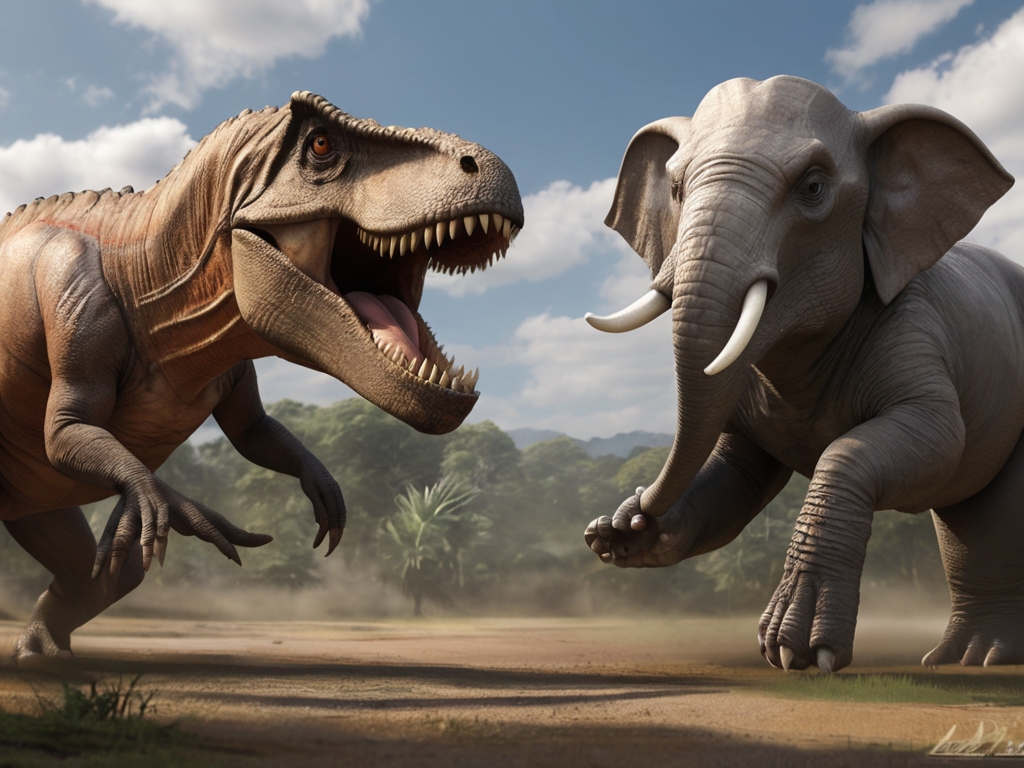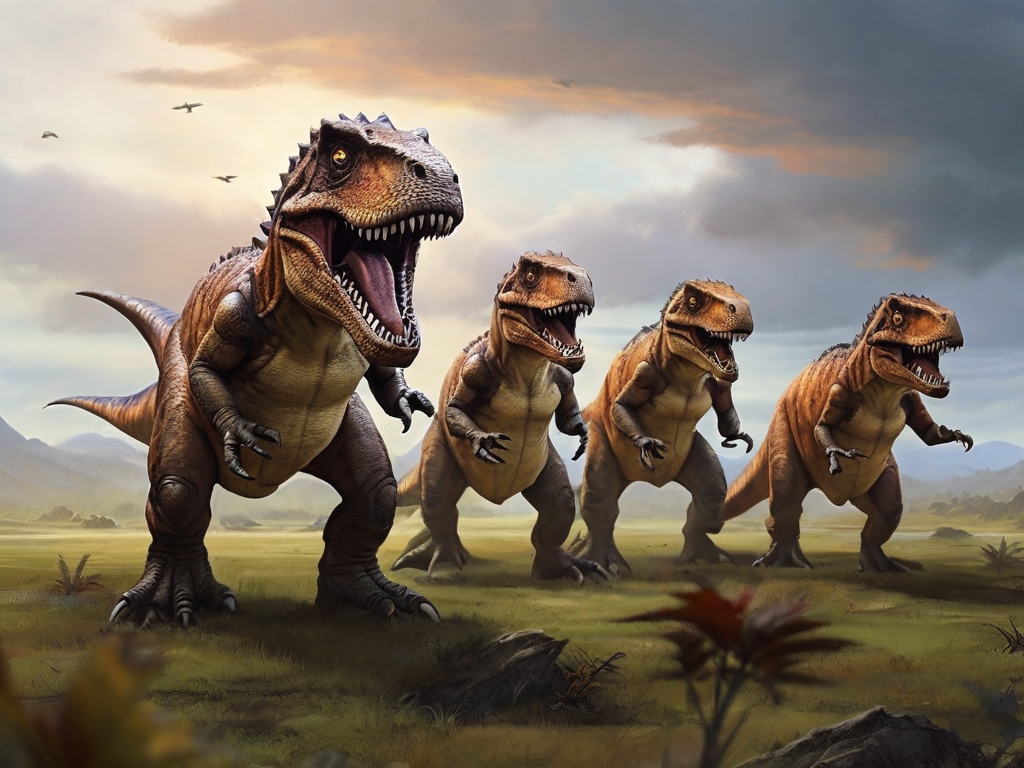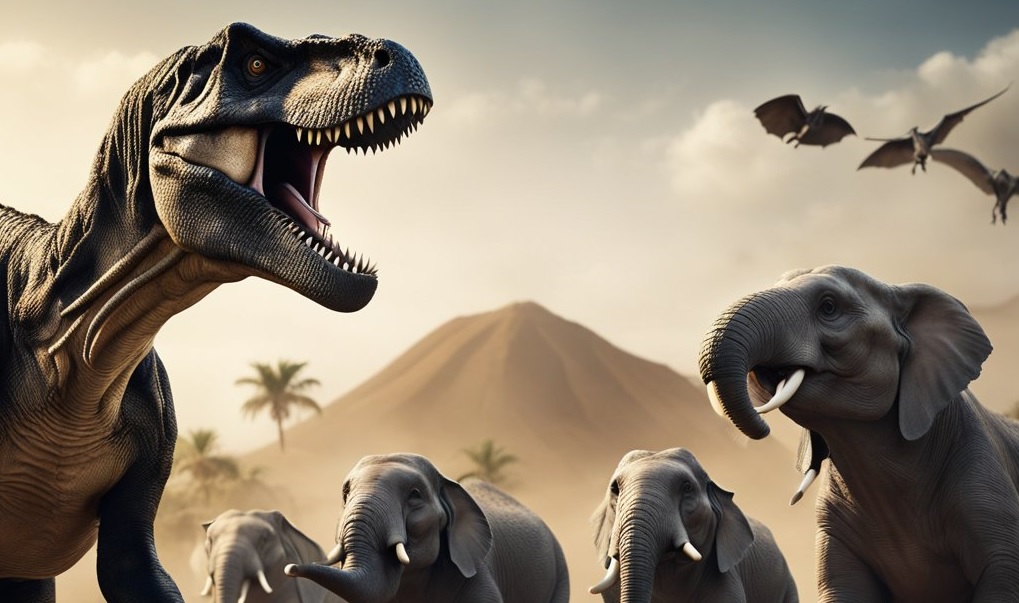An elephant herd vs a T-Rex pack, who would win? This is a question that has intrigued many people, and it’s not hard to see why. Both of these animals are incredibly powerful and have unique strengths and weaknesses. However, while it’s impossible to know for sure what would happen in such a hypothetical encounter, it is possible to analyze the situation and make some educated guesses.

To begin with, it’s important to understand the dynamics of an elephant herd. Elephants are social animals that live in matriarchal groups led by an older female. These groups can consist of up to 100 individuals and are highly organized. Each member of the herd has a specific role to play, and they work together to protect their young and defend themselves against predators.
On the other hand, T-Rex pack behavior is not as well understood since these animals are extinct. However, based on what we know about other predatory dinosaurs, it’s likely that T-Rexes hunted in packs to take down larger prey. They likely had a highly coordinated attack strategy and were able to communicate with each other to coordinate their efforts.
Key Takeaways
- The outcome of an elephant herd vs T-Rex pack encounter is impossible to predict with certainty.
- Elephant herds are highly organized and work together to protect their young and defend themselves against predators.
- T-Rexes likely hunted in packs and had a highly coordinated attack strategy.
Elephant Herd Dynamics

Social Structure
Elephants are highly social animals that live in tight-knit family groups called herds. These herds can consist of up to 100 individuals, with several females and baby calves and only one older bull. The social structure of the herd is matriarchal, meaning that the oldest and most experienced female elephant leads the group. The matriarch plays a crucial role in leading the herd, making decisions about where to go, what to eat, and how to protect the group from predators.
Communication Methods
Elephants use a variety of communication methods to stay connected with one another and coordinate their movements. These methods include vocalizations, such as trumpeting and rumbling, as well as physical touch, such as touching trunks and rubbing against one another. They also use their sense of smell to communicate, using their trunks to pick up scents from other elephants and their surroundings.
Role of the Matriarch
The matriarch of the elephant herd plays a critical role in maintaining the social structure and ensuring the survival of the group. She is responsible for leading the herd to food and water sources, protecting the young, and teaching younger elephants important survival skills. The matriarch is also responsible for maintaining order within the herd, resolving conflicts between individuals, and ensuring that everyone in the group is safe and healthy.
Overall, the social dynamics of elephant herds are complex and highly organized, with each member playing a critical role in the survival of the group. By working together and relying on the leadership of the matriarch, elephant herds are able to navigate their environment, find food and water, and protect themselves from predators.
Tyrannosaurus Rex Pack Behavior

Tyrannosaurus Rex, also known as T-Rex, was one of the most feared predators of the late Cretaceous period. Traditionally, T-Rex has been portrayed as a solitary hunter, but recent evidence suggests that they may have hunted in packs.
Hunting Strategies
Paleontologists studying a group of four or five T-Rex at a single fossil site in southern Utah say the find suggests the imposing predators may have hunted in packs [1]. The discovery of multiple T-Rex fossils at the same location indicates that they may have hunted together in groups, much like modern-day wolves.
Pack hunting would have given T-Rex several advantages. First, it would have allowed them to take down larger prey that they would not have been able to tackle alone. Second, it would have made it easier for them to defend their kills from other predators. Finally, pack hunting would have increased the chances of a successful hunt, ensuring that the T-Rex pack had enough food to survive.
Dominance and Territory
Pack hunting would have also required T-Rex to establish a dominance hierarchy within the group. This would have ensured that each member of the pack had a specific role to play in the hunt and that there was no unnecessary competition for resources.
T-Rex were also likely to have been territorial animals, defending their hunting grounds from other predators. This would have helped to ensure a steady supply of prey for the pack.
Although the evidence for T-Rex pack hunting is still limited, the discovery of multiple T-Rex fossils at the same location suggests that they may have hunted in groups. Pack hunting would have given T-Rex several advantages, including the ability to take down larger prey and defend their kills from other predators. It would have also required the establishment of a dominance hierarchy within the group and territorial behavior to defend their hunting grounds.
Comparative Analysis

Size and Strength
When it comes to size and strength, both elephants and T-Rexes are formidable creatures. However, elephants have the advantage of being much larger and heavier than T-Rexes.
According to Sheer Epic, an adult T-Rex could weigh between 6.8 and 9 tons, while elephants can weigh anywhere from 2.7 to 6.8 tons. Additionally, the T-Rex stood at a height ranging from 15 to 20 feet, while an elephant’s height varies between 8.2 and 13.1 feet. This size difference could give the elephants an edge in a physical confrontation with the T-Rexes.
Intelligence and Problem Solving
T-Rexes were undoubtedly intelligent creatures, elephants are known for their high level of intelligence and problem-solving abilities. According to National Geographic, elephants have been observed using tools, recognizing themselves in mirrors, and even mourning their dead. This intelligence could give the elephants an advantage in a battle against the T-Rexes, as they may be able to outsmart them in certain situations.
Survival Instincts
Both elephants and T-Rexes have strong survival instincts that have allowed them to thrive in their respective environments. However, elephants have the added advantage of living in large herds, which allows them to work together to protect themselves and their young. A post on Reddit suggests that a herd of elephants could potentially protect their young from a pack of T-Rexes for a full day. This ability to work together and protect each other could give the elephants an edge in a battle against the T-Rexes.
While both elephants and T-Rexes are formidable creatures in their own right, elephants may have certain advantages in a battle against T-Rexes due to their size, intelligence, and ability to work together in large herds.
Hypothetical Encounter Scenarios

Terrain Advantages
The terrain in which the hypothetical encounter between an elephant herd and a T-Rex pack takes place is a crucial factor to consider. Elephants are adapted to a variety of habitats, including savannas, forests, and deserts. They can use their size and strength to their advantage in open areas, while in wooded areas, they can use their tusks and trunks to maneuver through the trees.
On the other hand, T-Rexes are believed to have lived in forested areas during the Cretaceous period. They were also known to be ambush predators, so they may have an advantage in areas with dense vegetation. However, their large size and weight may limit their mobility in some habitats.
Group Coordination
Elephants are highly social animals that live in large herds led by a matriarch. They communicate with each other using a variety of vocalizations, body language, and chemical signals. In a hypothetical encounter with a T-Rex pack, the elephants may be able to use their social bonds to coordinate their movements and protect their young.
They may also be able to use their trunks and tusks to fend off the T-Rexes. However, T-Rexes are believed to have lived in family groups, so they may also have some level of group coordination.
Defensive Tactics
Elephants have a variety of defensive tactics that they can use to protect themselves and their young. They can use their tusks to stab predators, their trunks to push them away, and their size and strength to intimidate them. In a hypothetical encounter with a T-Rex pack, the elephants may be able to use these tactics to defend themselves.
However, T-Rexes are believed to have had incredibly strong jaws and sharp teeth, which could cause severe damage to the elephants. It is unclear how effective the elephants’ defensive tactics would be against such a powerful predator.
Overall, the outcome of a hypothetical encounter between an elephant herd and a T-Rex pack depends on a variety of factors, including the terrain, group coordination, and defensive tactics of both species. While elephants may have some advantages in terms of their social bonds and defensive tactics, T-Rexes were powerful predators with strong jaws and sharp teeth.
Impact on Ecosystems

Elephant Contributions
Elephants are considered as one of the most important species in Africa’s ecosystems. They play a crucial role in maintaining the balance of the natural habitats they live in. Elephants are known for their ability to create and maintain open spaces in forests and grasslands, which allows smaller species to coexist. They also help in seed dispersal, which is essential for the growth of vegetation in their habitats. Additionally, elephants create water holes used by other wildlife as they dig dry riverbeds when rainfall is low.
Based on a report published by the African Wildlife Foundation, elephants are responsible for the redistribution of nutrients through their dung and urine, which helps in the growth of vegetation. Elephants also help in controlling the population of certain tree species, which can otherwise dominate the ecosystem and reduce biodiversity.
Tyrannosaurus Rex Predation Effects
On the other hand, the impact of the Tyrannosaurus Rex on the ecosystem is quite different. Being a predator, the T-Rex is known for its ability to hunt and kill other animals. It is believed that the T-Rex was at the top of the food chain during its time. Its predation effects on the ecosystem are still being studied, but it is believed that the T-Rex may have played a role in controlling the population of other dinosaur species.
However, it is important to note that the T-Rex is an extinct species and its impact on the ecosystem is limited to the fossil record. While it may have played a role in the ecosystem during its time, it is not relevant to modern-day ecosystems.
In conclusion, the T-Rex may have had an impact on the ecosystem during its time, the contributions of elephants to modern-day ecosystems are much more significant. Elephants play a crucial role in maintaining the balance of natural habitats and are essential to the growth of vegetation and the survival of other wildlife species.
